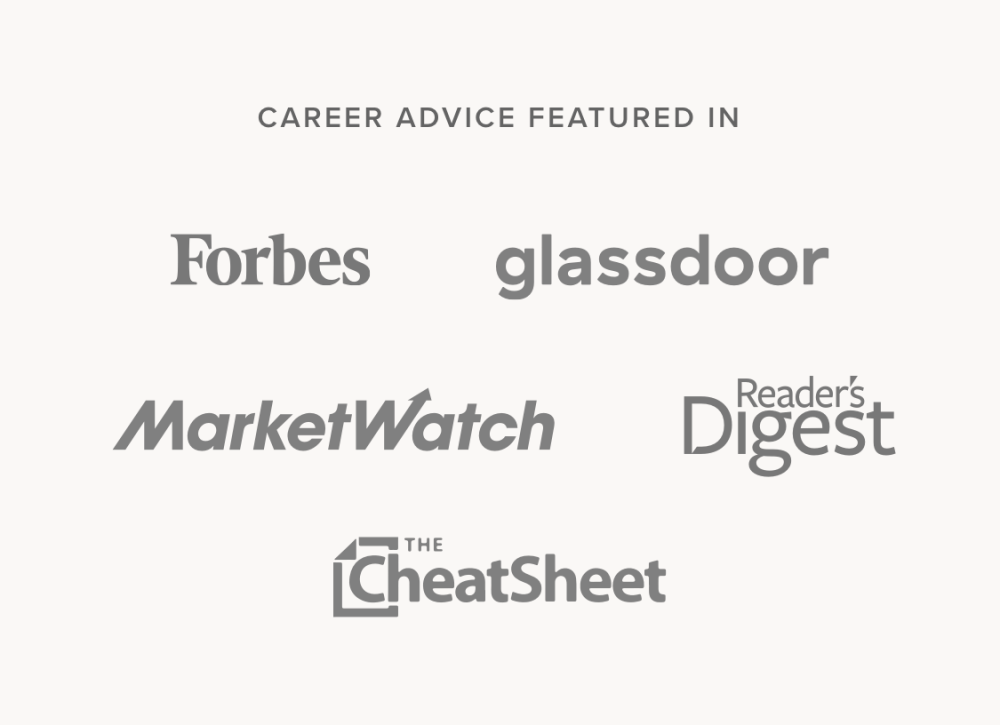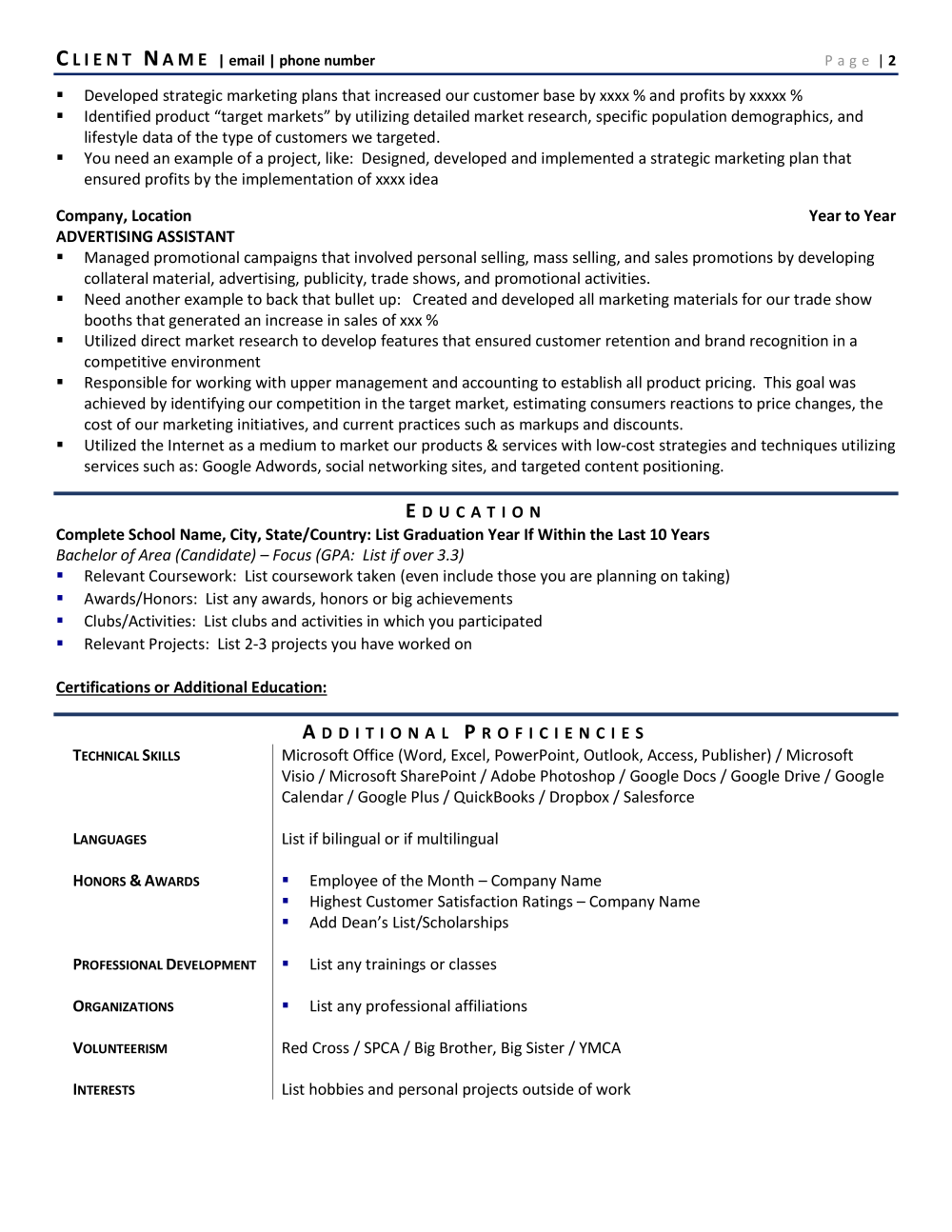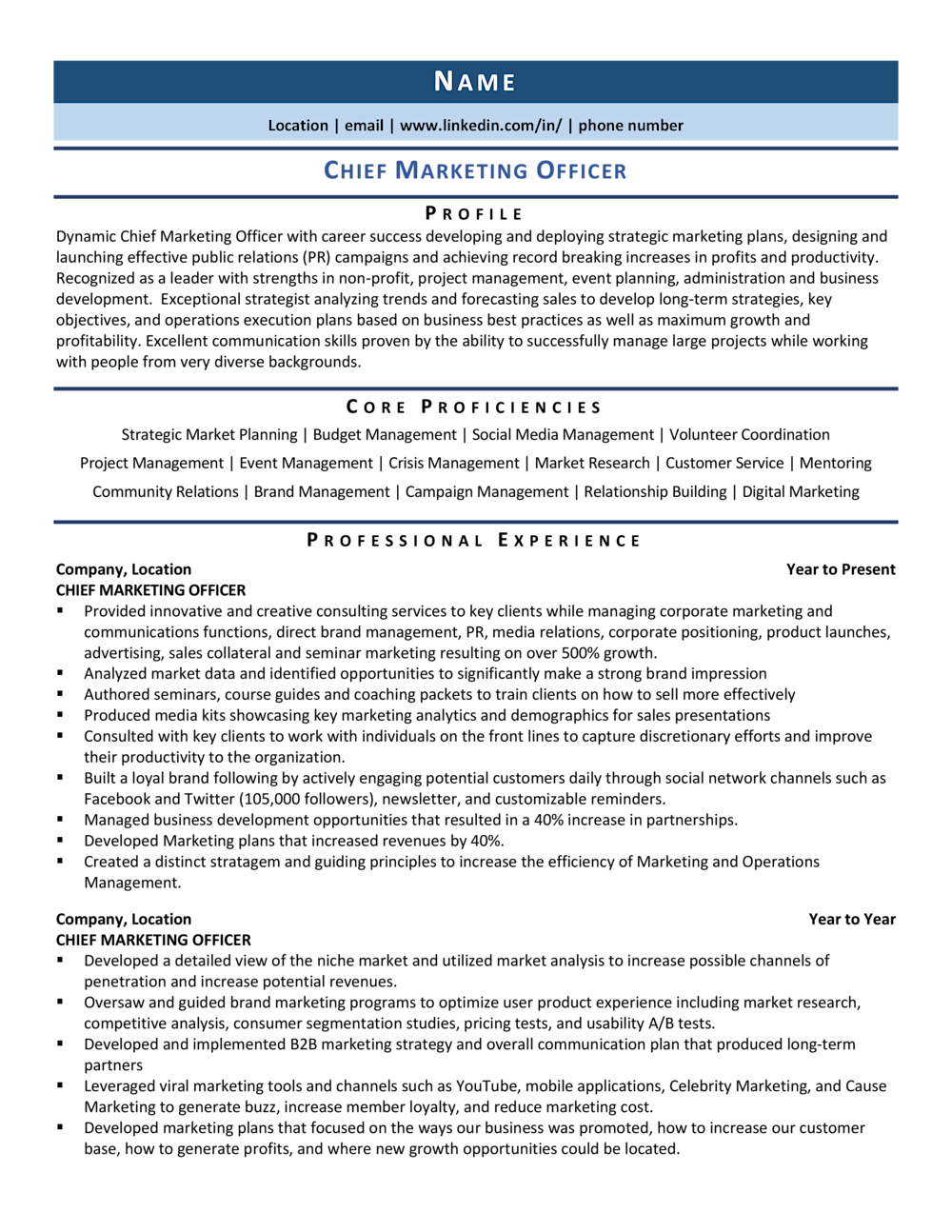Samples › Chief Marketing Officer
Chief Marketing Officer Sample
Download and customize our resume template to land more interviews. Review our writing tips to learn everything you need to know for putting together the perfect resume.


To land your dream role as a Chief Marketing Officer, you’ll need a powerful CMO resume that highlights your leadership skills, strategic thinking, and analytical abilities. Competition for these jobs can be fierce, so it’s important to ensure that your resume stands out from the crowd. That’s why the best way to increase your chances of landing an interview is to create a stellar resume that makes a positive first impression on any hiring manager who reads it.
That’s why we’ve created this CMO resume example guide, complete with all the tips and tricks you need to know to effectively convey your potential value to prospective employers. In this guide, we’ll explain the most essential elements of any resume, provide key insights to help you craft each major section of the document, and provide a great resume example that you can refer to as you go through the resume creation process.
How to write a resume
Before you can write a compelling CMO resume that motivates an employer to offer you an interview, you need to understand what recruiters and hiring executives are looking for in their next Chief Marketing Officer. When employers are looking for new talent, they are always searching for someone who can add value to their organization. That’s especially true for high-level positions like yours. If your resume fails to deliver a narrative that sells your potential value, companies will simply move on to the next candidate.
Great resumes are always built on a solid foundation that includes using the right format, structure, and narrative. In addition, your resume will need to focus on measurable achievements that can demonstrate how you’ve provided value in your previous jobs. We’ll cover each of these important concerns in the sections that follow.
Choosing a resume format
Choosing the right resume format is a crucial step in ensuring that your CMO resume gets the consideration it deserves. The modern resume uses one of three main resume formats: the reverse-chronological, functional, or hybrid format. Most job seekers will want to utilize the reverse chronological option since it tends to be the format that employers prefer.
If you’ve ever filled out a traditional employee application, you’ll likely recognize the chronological format’s approach to detailing employment history. You begin your work history by documenting the most recent or current job role that you’ve held. You then list other positions in reverse chronological order, going back at least ten years. Of course, if your executive experience goes back even further than that, you may want to expand the list to fifteen years and sometimes more.
Developing an easy-to-follow structure
It’s important to understand why structure matters when you’re writing a resume. Unlike most documents that people read from start to finish, resumes are typically skimmed by hiring managers and recruiters and usually need to capture the reader’s attention within the first five or six seconds. If the reader sees something of interest in that brief time, they’ll dig deeper into the document to learn more about you. If not, they may just set your resume to the side and go to the next applicant’s submission.
Obviously, you need to design your resume so that it can be easily scanned by human eyes. The best way to do that is to structure the document so that distinct types of information are all grouped together in easily recognizable sections. That will enable employers and recruiters to quickly find the information they want to see. One of the best ways to structure a reverse-chronological resume is to use the following sections:
Contact details: Position this key section at the top of your resume and include every detail that an employer or recruiter needs to contact you with an interview request or job offer. Those details should include your full name and phone number, a professional email address, and your LinkedIn URL. If you’re applying for a position in another city or state, you may also want to include your current location—but not your physical address.
Resume headline: Include a resume headline right below your contact details. This headline should include the job title that you’re seeking and descriptive text that highlights your qualifications. For example, you could write “Data-driven Chief Marketing Officer Focused on Brand Development and Expanded Market Share.”
Summary statement: This profile paragraph sits right below your job headline and serves as your primary introduction to the reader. It should include mention of your job title, years of experience, and primary specialties. The rest of the paragraph can highlight one or two key skills and measurable achievements that use real numbers to demonstrate your value.
Core competencies: This is the skills section of your resume. Make sure that you include between twelve and fifteen of your relevant hard and soft skills, presented in bullet point form. It’s also a clever idea to format this section of the resume into two or even three columns. That can help to save space and make your skill list easier for employers to skim.
Professional experience: Your work history or professional experience section needs to provide a brief look at your career trajectory. For each job that you’ve held over the last ten or fifteen years, list the job title, company name, and dates of employment. Then include those bullet point achievements that we mentioned earlier. List at least four accomplishments for each job.
Education: In this section, you should provide details about your educational credentials. Include your degree, the school you attended, and the dates of attendance. You can also include details about relevant coursework, as well as certifications and continuing education.
Highlighting your value
We would be remiss if we didn’t focus a little more attention on those achievements that you’ll be including in your resume summary and professional experience sections. We described them as measurable for a reason. If you quantify your achievements with real numbers that show how you provided value for previous employers, recruiters and prospective employers will have a better idea about how to measure your potential value for their organization.
To do that, you simply need to make sure that your achievements focus on how your results benefited those companies. Those benefits could include money saved, boosted revenue, reduced inefficiencies, etc. Always include numbers that quantify those results. For example:
Managed business development opportunities that resulted in a 40% increase in partnerships.
Built a loyal brand following by actively engaging potential customers daily through social media channels, adding 105,000 followers.
Developed marketing plans that led to revenue increases of $2 million in the first year of execution.
Beating the ATS
Of course, none of your hard work will matter if your resume can’t pass an applicant tracking system screening. Many companies use ATS technology to help them pre-screen applications and resumes to weed out applicants whose qualifications fail to meet the company’s needs. If you want to ensure that the right people get a chance to see your resume submission, you need to know how to satisfy those screening systems.
To do that, you’ll need to review the job posting and role description to identify the core qualifications that the company says it is looking for. Write down the exact words used to describe those skills and experiences, and then use those terms in your resume. You can add those keywords throughout the resume—in your summary, skills section, and work history—to ensure that the ATS finds them during its screening process.
Chief Marketing Officer (CMO) resume example
Before we go any further, it may be helpful to see a CMO resume example that shows how you can use this information to craft your resume document. The sample resume we’ve included below includes all the resume sections that we’ve discussed previously, so you can either use it as an example to guide you or as a customizable template.
Name
Title
City, State or Country if international
Phone | Email
LinkedIn URL
CHIEF MARKETING OFFICER PROFESSIONAL
Dynamic Chief Marketing Officer with career success developing and deploying strategic marketing plans, designing and launching effective public relations (PR) campaigns and achieving record breaking increases in profits and productivity. Recognized as a leader with strengths in non-profit, project management, event planning, administration and business development. Exceptional strategist analyzing trends and forecasting sales to develop long-term strategies, key objectives, and operations execution plans based on business best practices as well as maximum growth and profitability. Excellent communication skills proven by the ability to successfully manage large projects while working with people from very diverse backgrounds.
CORE COMPETENCIES
Strategic Market Planning
Budget Management
Social Media Management
Volunteer Coordination
Project Management
Event Management
Crisis Management
Market Research
Customer Service
Mentoring
Community Relations
Brand Management
Campaign Management
Relationship Building
Digital Marketing
PROFESSIONAL EXPERIENCE
Chief Marketing Officer
Company | Location | Year to Year
Responsibilities
Provided innovative and creative consulting services to key clients while managing corporate marketing and communications functions, direct brand management, PR, media relations, corporate positioning, product launches, advertising, sales collateral and seminar marketing resulting on over 500% growth.
Analyzed market data and identified opportunities to significantly make a strong brand impression
Authored seminars, course guides and coaching packets to train clients on how to sell more effectively
Produced media kits showcasing key marketing analytics and demographics for sales presentations
Consulted with key clients to work with individuals on the front lines to capture discretionary efforts and improve their productivity to the organization.
Built a loyal brand following by actively engaging potential customers daily through social network channels such as Facebook and Twitter (105,000 followers), newsletter, and customizable reminders.
Managed business development opportunities that resulted in a 40% increase in partnerships.
Developed Marketing plans that increased revenues by 40%.
Created a distinct stratagem and guiding principles to increase the efficiency of Marketing and Operations Management.
Marketing Manager
Company | Location | Year to Year
Responsibilities
Developed a detailed view of the niche market and utilized market analysis to increase possible channels of penetration and increase potential revenues.
Oversaw and guided brand marketing programs to optimize user product experience including market research, competitive analysis, consumer segmentation studies, pricing tests, and usability A/B tests.
Developed and implemented B2B marketing strategy and overall communication plan that produced long-term partners
Leveraged viral marketing tools and channels such as YouTube, mobile applications, Celebrity Marketing, and Cause Marketing to generate buzz, increase member loyalty, and reduce marketing cost.
Developed marketing plans that focused on the ways our business was promoted, how to increase our customer base, how to generate profits, and where new growth opportunities could be located.
Developed strategic marketing plans that increased our customer base by xxxx % and profits by xxxxx %
Identified product “target markets” by utilizing detailed market research, specific population demographics, and lifestyle data of the type of customers we targeted.
You need an example of a project, like: Designed, developed and implemented a strategic marketing plan that ensured profits by the implementation of xxxx idea
Advertising Assistant
Company | Location | Year to Year
Responsibilities
Managed promotional campaigns that involved personal selling, mass selling, and sales promotions by developing collateral material, advertising, publicity, trade shows, and promotional activities.
Need another example to back that bullet up: Created and developed all marketing materials for our trade show booths that generated an increase in sales of xxx %
Utilized direct market research to develop features that ensured customer retention and brand recognition in a competitive environment
Responsible for working with upper management and accounting to establish all product pricing. This goal was achieved by identifying our competition in the target market, estimating consumers reactions to price changes, the cost of our marketing initiatives, and current practices such as markups and discounts.
Utilized the Internet as a medium to market our products & services with low-cost strategies and techniques utilizing services such as: Google Adwords, social networking sites, and targeted content positioning.
EDUCATION
Complete School Name, City, St/Country: List Graduation Years If Within the Last Ten Years
Complete Degree Name (Candidate) – Major (GPA: List if over 3.3)
Relevant Coursework: List coursework taken (even include those you are planning on taking)
Awards/Honors: List any awards, honors or big achievements
Clubs/Activities: List clubs and activities in which you participated
Relevant Projects: List 2-3 projects you have worked on
Key hard & soft skills for a CMO
While we mentioned skills earlier in this CMO resume example guide, they’re important enough to warrant a deeper dive. In this section, we’ll consider both hard and soft skills and provide some examples of each that you can include in your resume. First, let’s examine these two distinct types of skills and why they matter.
Hard skills are measurable abilities that you use to successfully perform your job duties. They are usually learned through training, formal education, or hands-on use and are often related to your chosen job. They can be technical, like computer skills, or knowledge-based and specific to your industry and role. These types of skills are often mentioned in job postings as required qualifications.
Soft skills are harder to measure and can be developed even without training or formal education. Some are interpersonal in nature, enabling you to work more effectively with people. There are also soft skills related to your thought processes. The important thing to remember is that these skills can often be the deciding factor in hiring decisions.
Key CMO resume hard skills
Below, we’ve compiled a list of some of the most common CMO resume example hard skills:
Strategic market planning
Social media management
Digital marketing
Market research
Brand development
Project management
Budgeting
Data analysis
Key CMO resume soft skills
Don’t forget to include some of your core soft skills as well, which could include:
Verbal and written communication
Relationship building
Team building
Mentoring
Creative thinking
Customer development
Content creation
Leadership
Summary & last words
Writing your own CMO resume may take some time, but the result can be well worth the effort. The key is to focus on delivering a concise and value-driven message that sets you apart from the crowd. By following the tips and CMO resume example that we’ve provided in this guide, you should be well on your way to creating an effective basic resume for your job search efforts.
Introduction to ZipJob: Professional resume writers
Of course, you may want an even more impressive Chief Marketing Officer resume to ensure that your candidacy gets the attention it deserves. If that’s the case, then you can certainly benefit from relying on a professional resume-writing service and the expert assistance that experienced resume writers can provide. Fortunately, ZipJob’s team has you covered!
Why you should make use of our resume writing services to land your next job as a Chief Marketing Officer
At ZipJob, our team works with you to ensure that you receive the personalized, value-driven resume you need to compete for top CMO positions. We have experience in your industry, expertise in crafting resumes that enhance job search results, and deep insight into what today’s employers want to see from their top job candidates. A partnership with ZipJob’s expert writers can boost your chances of landing an interview and help supercharge your career success.
Resume writing service for Chief Marketing Officer: Let us write your resume
As an executive, you understand the importance of investing in your own career. A professional resume can be one of the most important investments you can make and can ensure that you always put your best foot forward during any job search effort. Take the next step in your career journey today by contacting us to learn how our expert writing services can help you get the CMO resume you need to land your next Chief Marketing Officer role.


